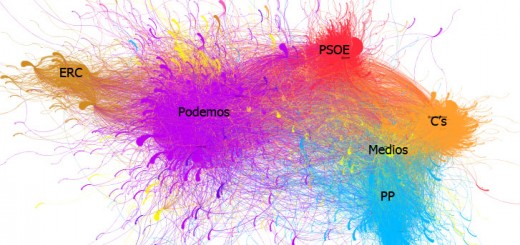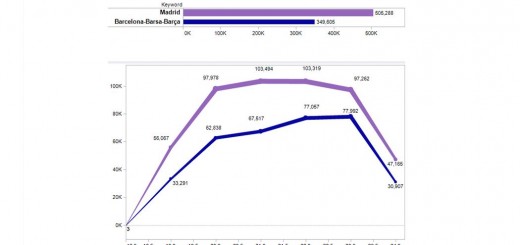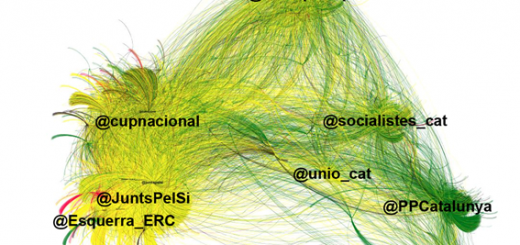#pídeleperdónalABC: la portada de la discordiaHow a single user can generate a TT
El sábado 14 de marzo de 2015 a Antón Losada se le debió atragantar el desayuno al ver la portada del ABC y quiso compartirlo en Twitter creando el hashtag #pídeleperdónalABC
Es el momento del hastag #pídeleperdónalABC pic.twitter.com/OfMKokug5k
— Antón Losada (@antonlosada) March 14, 2015
@antonlosada consiguió elevar el hashtag hasta la cima de los trending topics de España (TT) y mantenerlo casi todo el día con ayuda de múltiples usuarios indignados con la portada. La indignación se tornó en ironía en torno al hashtag, creando un auténtico festival de ingenio. Se dieron cita en esta propagación los tres factores: el origen, el impacto del mensaje y en contexto.
El origen, en este caso @antonlosada, poseía una amplia red en Twitter, 103.958 seguidores en el momento de publicar el tweet y un alto índice de propagación (71), medido con el índice-H de traity. El mensaje se presentaba en forma gráfica con la portada de la discordia, en el que la imagen lo decía todo. El contexto, formado por las personas a las que indignaba el mensaje, era muy propicio para la participación activa. Los tres factores estaban alineados para que el hashtag triunfara, como así ocurrió.
Como siempre, vamos a ver la evolución de la propagación en el tiempo midiéndola en tweets por minuto y comparándola con el alcance (calculado como la suma de seguidores de los autores de los tweets) en ese momento. Estos dos valores tienen diferente escala pero la gráfica los ajusta para poderlos comparar. Se han señalado los puntos de mayor alcance con los nombres de los usuarios con más seguidores que han publicado en ese momento, para ver si han afectado o no a la propagación. Como se puede observar en la gráfica, después de un pico de alcance suele haber un incremento de la frecuencia de tweets aunque no siempre proporcional. Insistimos, el alcance no lo es todo.
Si analizamos los tweets más difundidos, no encontramos a los usuarios marcados en la imagen anterior (salvo @la_tuerka). En su lugar aparecen usuarios con una red más pequeña pero que publicaron tweets más impactantes, como @pblcarmona que con 1.139 seguidores propagó este tweet más de 1.000 veces. También personajes ficticios cómo @BobEstropajo, @EsppeonzAguirre, @ForbesFlauta y @subversivos_ que se caracterizan por su sarcasmo. El iniciador del hashtag,@antonlosada, colocó dos mensajes en el top.
Otra forma de ver la propagación es por origen geográfico de los tweets. En este caso la localización se ha obtenido del perfil de usuario (la geolocalización fue muy baja, un 0,64% de los tweets). Se observa cierto contagio geográfico (mirar las islas Baleares) y una presencia constante de Madrid.
Finalmente, comprobamos la frecuencia de tweets por minuto para ver entre qué rangos se mantiene como TT. En este caso entre 35 y 100 tweets por minuto, similar a otras observaciones.
Nota: por apagón en la uc3m en el fin de semana, no se pudieron recoger los TT entre las 5:00 am y 2:00 pm. Se han completado con los datos que publica trendinalia.
Conclusiones
- Se dieron unas condiciones ideales para propagar el mensaje: un origen bien conectado, un mensaje impactante y un contexto muy sensibilizado
- Como en otros casos estudiados, los usuarios con mucho alcance (número de seguidores) ayudaron a expandir el mensaje aunque no de forma proporcional a su red. El alcance no lo es todo
- Los mensajes más difundidos no fueron de los usuarios con mayor alcance sino de los que publicaron un mensaje más impactante. Una vez más, la calidad del mensaje
- Aunque la propagación fue nacional, se observa algún contagio local
- Se confirma la cifra de 35-100 tweets por minuto para ser TT en España
On Saturday March 14, 2015 Anton Losada was choked on his breakfast when he saw the cover of the ABC newspaper and shared his discomfort on Twitter creating the hashtag #pídeleperdónalABC (apologizetoABC)
Es el momento del hastag #pídeleperdónalABC pic.twitter.com/OfMKokug5k
— Antón Losada (@antonlosada) March 14, 2015
@antonlosada´s hashtag became the top of the Spanish trending topics (TT) and stayed there most of the day helped by multiple users outraged by the cover. The indignation turned into irony around the hashtag, creating an amazing festival of wit. The three factors of the spread (origin, impact of the message and context) were important.
The origin, @antonlosada, had an extensive network on Twitter, 103,958 followers at the time of posting the tweet and a high rate of propagation (71), measured with the index-H with traity.com. The message showed the cover of the news and did not need any more words to create an impact. The context formed by the people who were outraged by the message was very conducive to active participation. The three factors were aligned for the hashtag to succeed, as happened.
As always, we will see the temporal evolution of the spread measuring it in tweets per minute and comparing it with the reach (calculated as the sum of followers of the authors of the tweets at that time). These two values had different scales but the graph adjusts it to compare them. The reach peaks were tagged with the names of the users with more followers who have published at that time, to see whether or not they have affected the spread. As can be seen on the graph, the frequency increase after a peak reach , but not proportional always. We insist, the reach is not enough to spread.
We analyzed the most widespread tweets. The most popular users weren’t the most spread (except @la_tuerka). Instead, the authors had a smaller network but most shocking tweets published as @pblcarmona with 1,139 followers this this tweet was spread more than 1,000 times. There were several users with pseudonym as @BobEstropajo, @EsppeonzAguirre, @ForbesFlauta y @subversivos_ characterized by their sarcasm. The initiator of the hashtag, @antonlosada, placed two tweets on the top spread.
Another way to see the spread is by geographical origin of the tweets. In this case the location is obtained from the user profile (geolocation was very low, 0.64% of the tweets). We observed some geographical spread (see the Balearic islands) and a constant presence in Madrid.
Finally, we checked tweets frequency per minute to see what ranges become a TT. In this case, it was TT with a frequency between 35 and 100 tweets per minute, similar to other observations.
Conclusions
- Ideal conditions were given to propagate the message: a well-connected source, a compelling message and a very sensitive context
- As in other cases, users with a large reach (number of followers) spread the message but not in proportion to their network. The reach is not enough to propagate
- The most spread tweets didn’t came from users with largest reach. Instead, the authors had smaller networks but most shocking tweets. Again, the quality of the message
- Although the spread was national, a local spread is observed
- The frequency 35-100 tweets per minute became a TT in Spain



